Neuronal Activity in Non-LNv Clock Cells Is Required to Produce Free-Running Rest:Activity Rhythms in Drosophila
- PMID: 30994046
- PMCID: PMC7153773
- DOI: 10.1177/0748730419841468
Neuronal Activity in Non-LNv Clock Cells Is Required to Produce Free-Running Rest:Activity Rhythms in Drosophila
Abstract
Circadian rhythms in behavior and physiology are produced by central brain clock neurons that can be divided into subpopulations based on molecular and functional characteristics. It has become clear that coherent behavioral rhythms result from the coordinated action of these clock neuron populations, but many questions remain regarding the organizational logic of the clock network. Here we used targeted genetic tools in Drosophila to eliminate either molecular clock function or neuronal activity in discrete clock neuron subsets. We find that neuronal firing is necessary across multiple clock cell populations to produce free-running rhythms of rest and activity. In contrast, such rhythms are much more subtly affected by molecular clock suppression in the same cells. These findings demonstrate that network connectivity can compensate for a lack of molecular oscillations within subsets of clock cells. We further show that small ventrolateral (sLNv) clock neurons, which have been characterized as master pacemakers under free-running conditions, cannot drive rhythms independent of communication between other cells of the clock network. In particular, we pinpoint an essential contribution of the dorsolateral (LNd) clock neurons, and show that manipulations that affect LNd function reduce circadian rhythm strength without affecting molecular cycling in sLNv cells. These results suggest a hierarchical organization in which circadian information is first consolidated among one or more clock cell populations before accessing output pathways that control locomotor activity.
Keywords: LNd; circadian; circuit; sLNv.
Conflict of interest statement
Figures
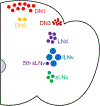
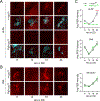
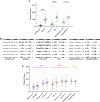
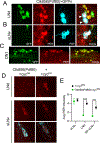
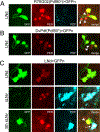
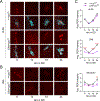


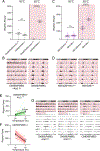
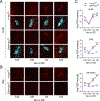

Similar articles
-
Overlapping Central Clock Network Circuitry Regulates Circadian Feeding and Activity Rhythms in Drosophila.J Biol Rhythms. 2024 Oct;39(5):440-462. doi: 10.1177/07487304241263734. Epub 2024 Jul 26. J Biol Rhythms. 2024. PMID: 39066485
-
Drosophila free-running rhythms require intercellular communication.PLoS Biol. 2003 Oct;1(1):E13. doi: 10.1371/journal.pbio.0000013. Epub 2003 Sep 15. PLoS Biol. 2003. PMID: 12975658 Free PMC article.
-
A Screening of UNF Targets Identifies Rnb, a Novel Regulator of Drosophila Circadian Rhythms.J Neurosci. 2017 Jul 12;37(28):6673-6685. doi: 10.1523/JNEUROSCI.3286-16.2017. Epub 2017 Jun 7. J Neurosci. 2017. PMID: 28592698 Free PMC article.
-
Genetics and molecular biology of rhythms in Drosophila and other insects.Adv Genet. 2003;48:1-280. doi: 10.1016/s0065-2660(03)48000-0. Adv Genet. 2003. PMID: 12593455 Review.
-
Molecular and circuit mechanisms mediating circadian clock output in the Drosophila brain.Eur J Neurosci. 2020 Jan;51(1):268-281. doi: 10.1111/ejn.14092. Epub 2018 Aug 16. Eur J Neurosci. 2020. PMID: 30059181 Free PMC article. Review.
Cited by
-
Entrainment of the Drosophila clock by the visual system.Neurosci Insights. 2020 Feb 5;15:2633105520903708. doi: 10.1177/2633105520903708. eCollection 2020. Neurosci Insights. 2020. PMID: 35174330 Free PMC article. Review.
-
Hsp40 overexpression in pacemaker neurons delays circadian dysfunction in a Drosophila model of Huntington's disease.Dis Model Mech. 2022 Jun 1;15(6):dmm049447. doi: 10.1242/dmm.049447. Epub 2022 Jun 28. Dis Model Mech. 2022. PMID: 35645202 Free PMC article.
-
Gap junction protein Innexin2 modulates the period of free-running rhythms in Drosophila melanogaster.iScience. 2021 Aug 20;24(9):103011. doi: 10.1016/j.isci.2021.103011. eCollection 2021 Sep 24. iScience. 2021. PMID: 34522854 Free PMC article.
-
A four-oscillator model of seasonally adapted morning and evening activities in Drosophila melanogaster.J Comp Physiol A Neuroethol Sens Neural Behav Physiol. 2024 Jul;210(4):527-534. doi: 10.1007/s00359-023-01639-5. Epub 2023 May 23. J Comp Physiol A Neuroethol Sens Neural Behav Physiol. 2024. PMID: 37217625 Free PMC article. Review.
-
Circadian rhythms are more resilient to pacemaker neuron disruption in female Drosophila.PLoS Biol. 2025 May 6;23(5):e3003146. doi: 10.1371/journal.pbio.3003146. eCollection 2025 May. PLoS Biol. 2025. PMID: 40327674 Free PMC article.
References
-
- Abruzzi KC, Zadina A, Luo W, Wiyanto E, Rahman R, Guo F, Shafer O, Rosbash M (2017) RNA-seq analysis of Drosophila clock and non-clock neurons reveals neuron-specific cycling and novel candidate neuropeptides. PLOS Genet 13:e1006613 Available at: http://dx.plos.org/10.1371/journal.pgen.1006613. - DOI - PMC - PubMed
-
- Beckwith EJ, Ceriani MF (2015) Experimental assessment of the network properties of the Drosophila circadian clock. J Comp Neurol 523:982–996. - PubMed
Publication types
MeSH terms
Grants and funding
LinkOut - more resources
Full Text Sources
Molecular Biology Databases

